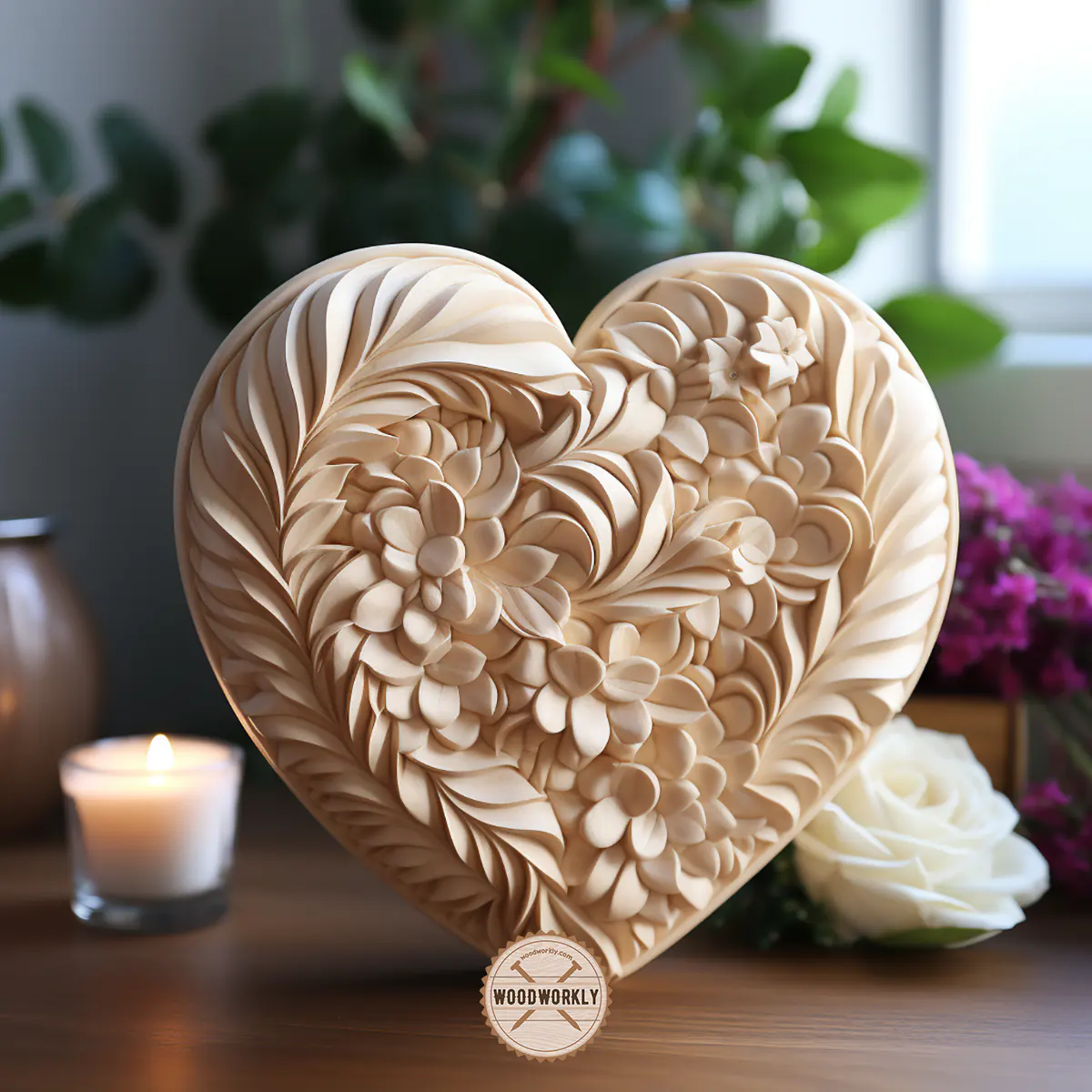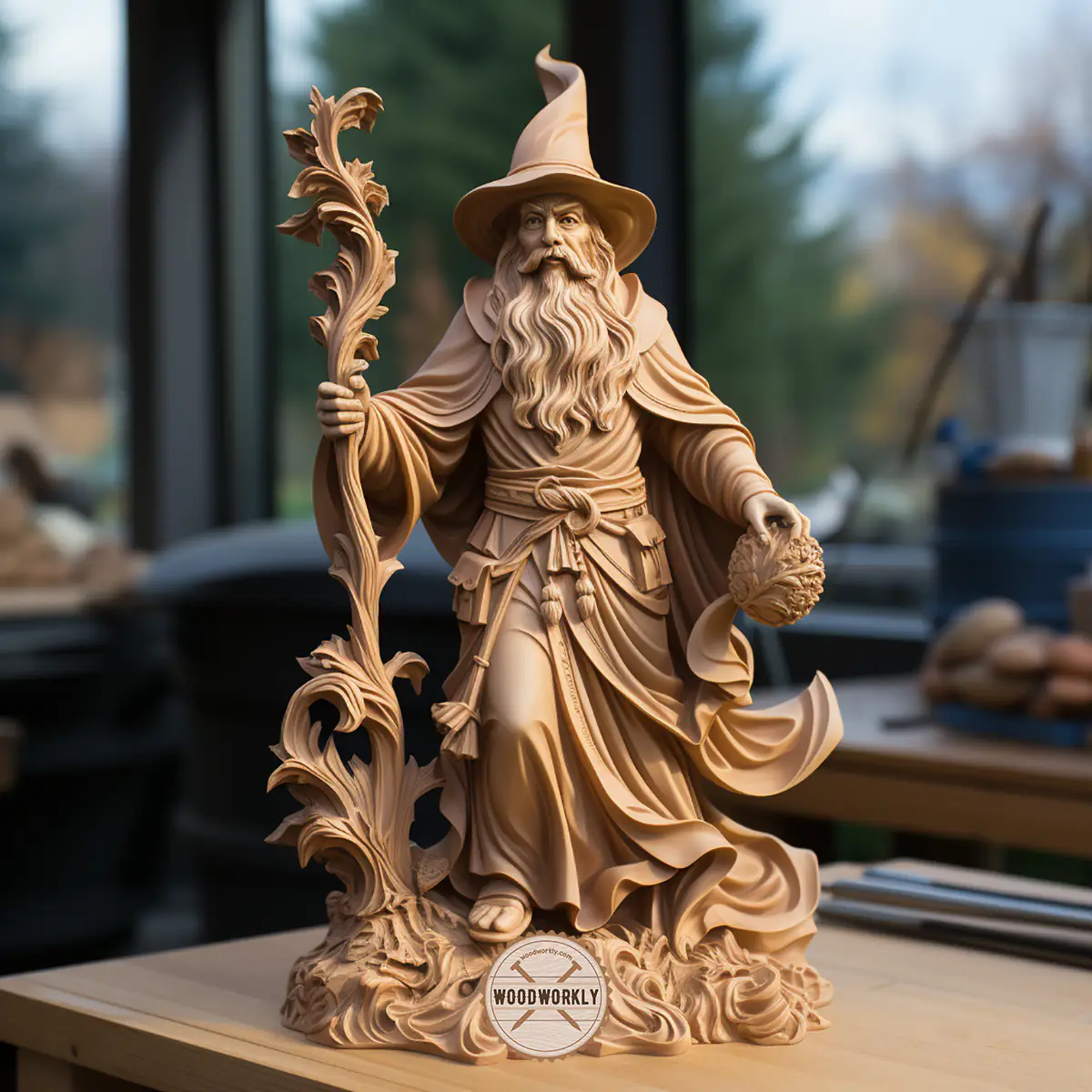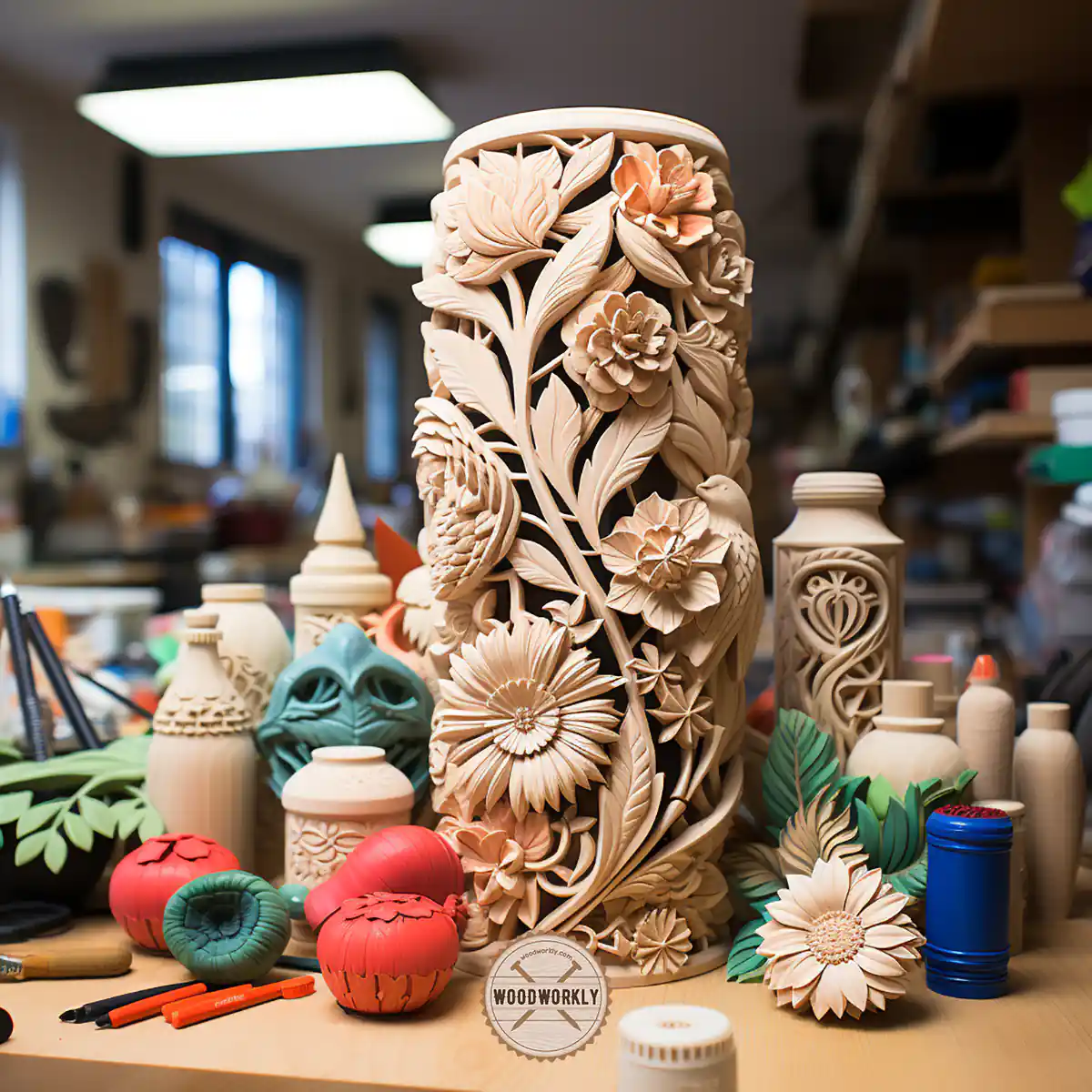Ever wondered what makes lime wood the go-to choice for carvers worldwide? Dive into the world of lime wood carving and discover why it’s the darling of both beginners and seasoned woodworkers!

Limewood is a popular wood when it comes to woodcarving and woodworking projects. Limewood is the same as basswood. They only differ because of their origin.
Limewood is known as the European version of basswood. But there are certain differences between these two you should know before carving with lime wood.
When I was new to wood carving, I was curious about using lime wood and I did some research with the help of experts.
Now with years of experience working with limewood, Here’s what I know about using Lime wood for carving.
Lime wood is excellent for woodcarving because of its strength and stable wood structure. Lime wood is extremely soft and crisp, and have high workability. Its durability and resistance to warping further enhance its suitability for various carving projects.
But there’s a lot more to know about carving with lime wood.

Lime wood is a highly recommendable wood especially for beginners due to the various properties it has.
From this article, I’ll discuss why lime wood is useful in carving, the properties of lime wood, the advantages, and disadvantages of taking lime wood for your next woodcarving project, how to carve lime wood, and many more with examples.
So, let’s get going!

First of all, you need to have a good understanding of the wood. Therefore, let’s have a quick look at what is lime wood.
What is Limewood?
Lime wood, known by various names depending on the region—basswood in the United States, linden in parts of Europe—is a type of wood derived from trees belonging to the Tilia genus.
This versatile wood is admired by woodworkers worldwide for its unique qualities, making it an ideal material for a wide range of projects, especially carving.

Uses of Limewood
Let’s have a closer look at how lime wood is used in the real world revealing its versatility and broad appeal.
Furniture Making and Cabinetry
Lime wood is widely used in furniture making and cabinetry. Its softness allows for intricate detailing, while its uniform grain contributes to a polished and professional end product.
Musical Instruments
The acoustic properties of lime wood make it a favored choice for crafting musical instruments, including guitar bodies.
Musicians appreciate not just the tonal quality of the instruments but also the craftsmanship made possible by lime wood’s workability.
Wood Carving
But where lime wood truly shines is in the realm of carving. From spoons and bowls to high-relief artistic pieces, lime wood allows carvers, whether novices or experienced, to express their creativity in countless ways.
In my personal experience, there’s something almost meditative about carving lime wood.
Its softness lets the tools glide with ease, the shavings fall gently, and before you know it, your vision begins to take form.
Whether it’s a carved spoon serving as a unique addition to your kitchen or a high-relief carving adding depth to your living room, lime wood brings art and functionality together in beautiful harmony.
Now you know what kind of wood you’re going to work with. Let’s see the use of lime wood in wood carving.

Why Lime Wood Good for Carving?
Lime wood is excellent for intricate woodcarving and woodworks exceptionally easy to work with tools and materials.
It is popular in hand whittling, woodcarving, instrument making, model building, picture framing, and many more.
The workability of lime wood is high and important when working with the close grain structure of wood.
Most of the woods are not good for carving because especially when carving edges, they tend to break and never give a sharp and smooth finish.
The cracks and rough edges make your final output dull.
But when comes to lime wood, it does not break when carving edges and very easily smoothen the surface, and give a nice appeal.
Lime wood is very soft and lightweight, you don’t feel much pressure even when you’re hand carving with a huge block of lime wood.
Whilst also carving, nailing, turning, gluing, polishing, and staining effectively.
Lime wood keeps shape while carving and fibers don’t get fuzzy or hairy when cutting with a chisel or knife, like most other woods. It has nice linear grain without any defects.

Lime Wood Properties that are Important in Wood Carving
1. High Workability
Lime wood is the easiest wood to work on. It is soft and light wood. Even though lime wood is softwood, it is comparable to oak wood in terms of strength.
Wood carvings that are made out of lime wood have great strength than other softwood carvings.
Lime wood has great split resistance and fuzziness which is pretty much useful when working with sharp cutting tools.
Because of its high workability, lime wood is the best wood for hand carving.
Lime wood screws, nails, and glues easily and can be stained and sanded with a smooth finish. It dries easily with little degrade.
Lime wood has relatively high shrinkage but has great dimensional stability when dry.
2. Nice Appearance
Color and appearances are the top factors that you should consider in woodcarving. Lime wood has an even and fine texture that results in beautiful carvings.
The pale white-cream color is uniform and spread all over the wood. This pale cream color will turn yellow over time.
3. Non-Toxic
Besides the health risks due to dust while working with wood (common in all types of wood) there are no health effects when working with lime wood.
Lime wood is an odorless, non-toxic, and food-safe wood. You can use lime wood to carve children’s toys, kitchen utensils, without any issue.

Pros and Cons of Using Lime Wood
Here, I’ve discussed the advantages and disadvantages I have experienced when working with lime wood for a long time.
Advantages of Lime Wood for Carving
- Sustainable woods are available
- Readily available
- Easy to carve because of being soft
- Lightweight
- Easy to bring details because of great properties
- High strength
- Easy to finish
Disadvantages of Lime Wood for Carving
- Less durable than most of the wood available on the market
- Not good for large wood carving projects
- Expensive than most other wood types

How To Carve Lime Wood in 3 EASY Steps
If you’re a beginner at woodcarving with lime wood, you can try it.
There are several steps you should follow to do lime wood carving properly. Don’t hesitate to try it.
Try to carve simple projects first before heading into the advanced ones. That’s how woodworkers do.
Here’re the steps you need to follow when carving limewood,
- Make a sketch
- Chisel the shape
- Finishing and sanding
Now I’ll discuss each of the above steps in detail to carve limewood properly without making any mistakes.
1. Make A Sketch
This is the most important part that every woodworker should do, but most of them skip it.
Sketching is very important to get an idea about what you’re going to make and how you’re going to do it.
If you’re sketching has enough details, you can follow steps to carve your object easily by completing each of those details one by one separately.
If you’re designing a simple object to carve, draw a simple sketch with its outlines directly on the lime wood surface without going for a paper sketch.
This method is effective for simple woodcarving projects.
If you’re going for a sculpt with a large number of details, I highly recommended taking time and sketching on paper with its front view, back view, and side views.
This will create a 3D model in your mind to get the perfect output.
By sketching before the woodcarving, you’ll be able to visualize the ultimate output of the project with extra motivation.
If you’re not good at drawing the sketch over wood, You can try 3D modeling software like Blender or 3Ds Max, to draw the sketch, take a printout and stick it to the wood.
Tip: Blender is an open sources software with lots of tutorials on YouTube

2. Chisel The Shape
Using a chisel, you can chip away the lime wood though a particular direction.
For example, if you’re willing to carve an animal, then shape your lime wood separately for the head, body, legs, and tail.
By separating parts at the initial stages, you can easily carve the project without continuously looking at the sketch.
When you’re using a chisel, with lime wood, you’ll feel very easy to do the carving, because of the high workability and lightweight of the wood.
This is why lime wood is excellent for beginner woodworking projects.
You can use a knife with a sharp blade to add little details with the combination of a chisel.
3. Finishing and Sanding
Lime wood is a type of wood that has all the quality befits that woodworkers love. Sanding is easy with lime wood because It easily gives a smooth surface as you wish.
After finishing the sculpting part, remove the debris with help of a vacuum cleaner or brush. Then do the sanding manually.
For the finishing part, you can stain the object or add paint or coating to get the appeal you like. Lime wood stains well and dry easily.

Limewood Carving Ideas
Lime wood is great for less experienced carvers and intricate projects. Here I have given you a list of woodcarving ideas you can easily do with lime wood.
These will teach you wood carving basic steps and lots of great techniques as a beginner.
Here’s a list of some of the most popular limewood carving ideas,
- Simple Owl
- Leaf art wood
- Carve a bear
- Gnome project
- Carve a heart
- Carve a spoon
- Carve a bowl
By starting your woodcarving with the above projects, I’m hundred percent sure you’ll learn a lot of new things that’ll be useful to become a pro player in the field.

Does Soaking Lime Wood Make It Easier to Carve?
Yes, soaking lime wood makes the wood easier to carve. But there’re some drawbacks.
Mostly soaking is essential for wood bending, not for carving. But soaking wood before carving may give you several advantages. But there’re some cons as well.
Soaking Lime Wood: The Advantages
Soaking lime wood in water does make the wood easier to carve.
By absorbing the water, the wood fibers become softer and more pliable, allowing your carving tools to cut through the material with even greater ease.
This can be particularly beneficial if you’re working on a detailed project that requires precision and smooth cuts.
For instance, I remember a time when I was creating a miniature animal figurine from lime wood, and the intricate detailing in the face was proving to be a challenge.
I decided to try soaking the wood, and I was amazed by how much more control I had over my cuts, enabling me to capture the finer details more effectively.
Proceed With Caution: The Drawbacks
While soaking does make lime wood easier to carve, it’s essential to be aware of the potential downsides.
Prolonged exposure to water can weaken lime wood, increasing its susceptibility to cracking or splitting.
In addition, the absorbed moisture can affect the wood’s stability, leading to unwanted warping over time.
During my early days of wood carving, I once left a lime wood block soaking overnight, thinking it would make the carving process even easier the next day.
However, I soon discovered the downside when the wood started showing signs of splitting.
It was a learning experience that reminded me of the importance of balance and caution in treating my materials.
A Balanced Approach to Soaking Lime Wood
To strike a balance, the key is to control the soaking duration of limewood and ensure the wood dries thoroughly before carving.
Generally, soaking for a few hours is enough to achieve the desired softness without compromising the integrity of the wood.
Once soaked, allow the lime wood to dry completely before starting your carving process.
The drying duration can vary depending on the size of the wood piece and the ambient conditions, but it’s essential not to rush this step.
Patience, as they say, is a virtue, and that certainly rings true in wood carving!
As you can see, while soaking lime wood can make it easier to carve, it’s a method that requires a thoughtful and cautious approach.

How Long Should Lime Wood Dry Before Carving?
As a rule of thumb, for a carving project, it’s best to allow lime wood to dry for at least six months before you start carving.
However, this is a minimum guideline and drying can take longer, depending on the factors I mentioned above.
I’ve learned from my experiences that patience in the drying process pays off in the long run.
Once, I left a lime wood piece to dry for almost a year before I started carving a detailed statue from it.
The results were remarkable, with the final piece showing no signs of warping or cracking even years later.
Drying time can change due to humidity and temperature levels.

Key Factors in Drying Lime Wood
1. Size and Moisture Content
The size of the wood piece and its initial moisture content are the first factors to consider when drying lime wood.
The thicker the wood and the higher the moisture content, the longer it will take to dry.
As a general guideline, for a one-inch thick piece of lime wood, you should allow at least one year of drying time for each inch of thickness.
2. Environmental Conditions
The environment where you dry the wood can also significantly influence the drying time.
Wood dries faster in warm, dry conditions with good airflow. Using a dehumidifier or a fan can help accelerate the process.
However, drying the wood too quickly can lead to checking (surface cracks), so it’s essential to monitor the process carefully.
Speeding Up the Drying Process
In cases where you’re in a hurry, there are ways to speed up the drying process.
Placing the wood in a warm, dry area, using a dehumidifier, or a fan to circulate air can hasten drying.
However, remember that faster isn’t always better when it comes to drying wood.
Rushing the process can lead to defects like cracking or warping, so it’s always important to maintain a balance.

What Other Woods Can I Use for Carving
As an experienced woodworker, I recommend you start your wood carving journey with simple efficient wood-like lime wood.
But due to the high cost of non-availability in the market, here I have given you the second-best options you can go for your next wood carving project.
Aspen Wood
Aspen wood is a top-quality wood for many woodcarving projects. It is hardwood with great strength. Workability is good and easy to handle.
It has split resistance as lime wood, make it easy to carve edges and for a smooth surface.
Oak Wood
Oakwood is great for large woodcarving projects. The strength is excellent. If you’re not going to use lime wood because of its less durability, oak wood is the best option you can go for.
It has great durability, and you can keep your beautiful Oakwood carvings lifelong with proper maintenance.
That’s it, folks! Now you know all you need to know about using lime wood for carving.

Let’s answer some frequently asked questions.
FAQs
Why is Lime Wood Good for Carving?
Lime wood is a favorite choice for carving due to its soft and even grain structure, making it easy to carve, allowing for intricate and detailed work, and its non-toxic nature ensures safety during handling.
Can Soaking Lime Wood Make Carving Easier?
Yes, soaking lime wood can soften the wood fibers and make them more pliable, thus easing the carving process, but be cautious as it can also weaken the wood and make it prone to cracking or splitting.
What are the Benefits of Lime Wood for Carving?
The benefits of lime wood include high workability due to its softness and even grain, a consistent appearance due to its pale color and lack of defects, and safety due to its non-toxic nature.
What are Some Popular Lime Wood Carving Projects?
While lime wood is a popular choice for carving, other alternatives include aspen for its easy carving and light color, or oak, which has a beautiful grain and a rich, warm color but is harder to carve.
Where Can I Find Lime Wood?
Lime wood, or basswood, can typically be found at most lumberyards or woodworking supply stores and can also be purchased online.
Is Lime Wood and Basswood the Same?
Yes, lime wood and basswood are two names for the same type of wood that comes from the Tilia genus of trees, with the name varying depending on the region.
Did I cover all you wanted to know about: Lime wood for Carving?
There is no second thought about lime wood, it is the undefeatable popular choice for woodcarvers among beginners and professionals due to its great qualities.
Fine straight grain makes it easy to carve compared to other wood types.
Lime wood is excellent for carving due to its soft, uniform grain and fine texture, making it easy to work with for both beginners and experienced woodworkers. Its durability and resistance to warping also make it a popular choice for carving projects.
In fact, if you prove you’re good are lime wood carving projects with continuous practice, you can make your lime wood carving into a business, sell products, or create DIY excellent gifts for your family and friends.
Ultimately practice will make you perfect.
Lime wood is smooth and takes details nicely.
It has great strength as well.
Here in this article, I have widely discussed why lime wood has become so much popular in the wood carving world and what makes it the perfect wood for beginner woodcarving projects.
I hope now you have a clear idea of Lime wood for carving for your next carving project.
My advice is to try every single wood after you have done with lime wood to get the best experience. It’ll be valuable for you in the near future.